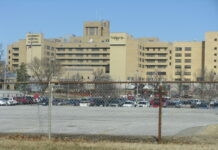Photo credit: DiasporaEngager (www.DiasporaEngager.com).
Diagnosis of Botulism
Each of the following sections begins with a summary of evidence. Following the evidence are the CDC recommendations for diagnosing, monitoring, and treating suspected botulism as well as (in certain sections) key points for clinicians. In addition, a summary of the recommendations and key points is provided (Supplementary Box; https://stacks.cdc.gov/view/cdc/105129).
Botulism typically produces a distinctive syndrome of cranial nerve palsies that can be followed by bilateral, symmetric, descending flaccid paralysis, affecting proximal before distal limb musculature, that might progress to respiratory failure and death. The extent and severity of paralysis is proportional to the dose of toxin. Patients with botulism are described as alert and oriented, although ptosis, ocular muscle paralysis, voice changes from vocal cord paralysis, and gait disturbance from skeletal muscle paralysis can be mistaken as manifestations of drug or alcohol intoxication or mental status changes of other origin; patients rarely have sensory deficits and rarely report pain (3,42,43). However, the diagnosis of botulism is frequently delayed or even missed.
Challenges in the Diagnosis of Botulism
Although the progression of paralysis in patients with botulism is described as unique and recognizable, in practice, when a patient is first seen by the health care provider, the neurologic symptoms and the sequence of progression both are sometimes misdiagnosed (3,14). The reasons for initial failure to diagnose botulism in subsequently confirmed cases has been investigated most productively in outbreaks, in which cases initially misdiagnosed were eventually identified by outbreak investigators. Outbreak investigations in which some botulism cases were only identified after the patients had been discharged with alternative diagnoses highlight the potential for delayed or missed diagnoses (35,38) (CDC, unpublished data, 2016). The critical initial treatment and management decisions for patients with suspected botulism must be made based on clinical findings. Botulinum antitoxin, the only specific therapy for botulism, should be administered as quickly as possible. Laboratory confirmation can take several days, and delaying administration of antitoxin to a patient with a high or medium likelihood of botulism while awaiting laboratory results can worsen the patient’s outcome (3,35,44,45). The diagnostic challenges resulting from the variations in the spectrum of signs and symptoms of botulism were highlighted in the delayed recognition of a large foodborne botulism outbreak, in which some patients initially received diagnoses of myasthenia gravis, stroke, or psychiatric disorders (46). Most of the affected patients were reported to have had the classic signs and symptoms of botulism (46). In recent literature reviews and a classical case series, botulism was most commonly misdiagnosed as myasthenia gravis and Guillain-Barré syndrome (13,14,16,30,31). A wide variety of common and unusual etiologies have been included in differential diagnoses of individual cases (e.g., cerebrovascular accident, Lambert-Eaton syndrome, meningitis, encephalitis, and tick paralysis) (13). In a review of 332 patients with possible botulism for which CDC consulted during 1980–2016, the treating physician provided alternate diagnostic considerations for 274 cases (83%); for these, treating physicians reported a range of zero to six illnesses other than botulism as possible diagnoses at the time of emergency public health consultation. The most common differential diagnoses were Guillain-Barré syndrome (99 cases) and myasthenia gravis (76 cases). For 160 botulism cases that occurred during 2009–2015, treating physicians who consulted with the CDC botulism clinical consultation service listed botulism first for 90% (144) of cases, second for 6% (10), third for 3% (five), and fourth for <1% (one).
In children and adolescents, a differential diagnosis was reported in 79 (22%) cases; the most commonly listed alternate diagnoses were myasthenia gravis (22 cases; 28%), poisonings and intoxications (20 cases; 25%), Guillain-Barré syndrome (11 cases; 14%), and poliomyelitis (nine cases; 11%) (31). Misdiagnosis of botulism, including in outbreak settings, might occur because botulism is much less common than other diseases with similar signs and symptoms, such as myasthenia gravis and Guillain-Barré syndrome. In addition, failure to perform a thorough neurologic examination and identify the typical neurologic findings might decrease the likelihood of considering botulism (26). Although rarely reported, atypical findings or progression, such as reported asymmetry of deficits, might explain diagnostic difficulties (33,34,38,47).
Signs and Symptoms
In reviews and analyses conducted while gathering evidence for these guidelines (13,14,16,30,31,36), the most commonly reported symptoms among patients with botulism were dysphagia; blurred vision; slurred speech, difficulty speaking, and hoarse voice; gastrointestinal symptoms; dry mouth; shortness of breath; and diplopia. The most common signs were descending paralysis, ptosis, and ophthalmoplegia.
Signs and symptoms of botulism evolve over a period of hours to a few days. Initially, subjective symptoms of minor visual changes or (in patients with foodborne botulism) abdominal discomfort might occur, followed by progressive cranial palsies, which might then be followed by descending flaccid bilateral paralysis. In different patients, the maximum extent of neurologic signs might range from only ptosis or mild cranial nerve findings to descending bilateral flaccid paralysis, encompassing cranial nerve–innervated respiratory, extremity, and axial muscles. Early gastrointestinal symptoms (e.g., nausea and vomiting) are more common among persons with foodborne botulism than with other types of botulism (13,14,16). For example, vomiting was reported by 172 (50%) patients with foodborne botulism compared with three (5%) with wound botulism (14). Whether gastrointestinal signs and symptoms are caused by botulinum neurotoxin, other clostridial products, or nonclostridial substances related to food spoilage is unknown. Whether foodborne botulism from intentional contamination of food with purified botulinum toxin would cause gastrointestinal signs and symptoms is unknown (14). Constipation is often reported as an early symptom among children (31). Infants and young children might not be able to describe symptoms such as double vision; signs were more commonly reported than symptoms among children (31). The terminology used to describe the neurologic manifestations of botulism in infants differs from that used for children and adolescents; for example, in one analysis, hypotonia, weak cry, and poor feeding were reported among the three infants with foodborne botulism but not in other children (36).
Botulism is typically described as producing symmetric neurologic deficits, and the pathophysiological mechanism of the disease (i.e., circulatory distribution of the toxin to neuromuscular junctions) (12) is consistent with this description. Certain detailed case studies describe individual patients with asymmetric neurologic deficits (47). Larger case series have reported asymmetry or unilateral neurologic deficits in the range of 6%–15% of patients (13,16). These data are difficult to interpret because many case series present the findings from clinical chart abstractions; data in charts might be missing or incomplete and are typically reported by multiple providers with varying levels of expertise and charting habits. Unreactive pupils are expected in patients with botulism but were reported in only 25% in a large series of confirmed cases (i.e., cases with a positive specimen or epidemiologic association of a clinically compatible case with a case with a positive specimen) (13). Although rare, symptoms such as fever, nondescending paralysis, and altered mental status have been reported (13,31). Botulism typically affects proximal before distal muscles; however, equal muscle strengths or even distal muscles weaker than proximal have been reported (13). The reasons for these rarely reported findings might include an inadequately performed or recorded neurologic examination, a preexisting focal deficit, coincident processes such as infection, or a rare variance from the classical syndrome.
Respiratory failure without preceding neurologic deficits has rarely been reported as the presenting symptom. Such a presentation is highly improbable and likely represents an inability to perform a timely, thorough neurologic examination, which would have revealed the cranial nerve palsies that precede pharyngeal compromise and respiratory muscle paralysis.
In a series of 72 patients with sporadic (i.e., single) cases of botulism, most had a chief complaint that included symptoms reflecting the classical neurologic deficits of botulism (i.e., slurred speech, weakness, and difficulty swallowing). However, some of the primary signs and symptoms were less indicative of botulism (e.g., gastrointestinal symptoms only, back pain and difficulty using a walker, altered consciousness, and lip and tongue numbness) (CDC, unpublished data, 2016). Patients whose primary signs and symptoms did not reflect classical neurologic deficits of botulism were more likely to have a delayed diagnosis of botulism (CDC, unpublished data, 2016).
Key Points for Clinicians
- Be aware of the spectrum of signs and symptoms of botulism, ranging from limited cranial nerve palsies (e.g., ptosis) to respiratory failure and complete extremity paralysis.
- Be aware that the respiratory system might be compromised early in the illness, when respiratory muscles (e.g., diaphragm) are unaffected but the upper airway is compromised from paresis of cranial nerve muscles, resulting in pharyngeal collapse or pooling of secretions.
Recommendations
- Consider botulism when myasthenia gravis or Guillain-Barré syndrome are suspected and in a patient with unexplained symmetric cranial nerve palsies, with or without paresis of other muscles.
- Conduct thorough, serial neurologic examinations to detect the neurologic deficits of botulism and their progression.
- If botulism is suspected, immediately contact the local or state health department’s emergency on-call staff to arrange an emergency expert clinical consultation and, when indicated, request botulinum antitoxin from CDC.
Ancillary Testing
Background
Results from routine laboratory tests, including complete blood counts, examination of cerebrospinal fluid (CSF), and radiologic studies, are typically normal in patients with botulism. In Guillain-Barré syndrome, CSF protein concentrations are often elevated, especially by the second week of illness (48). In patients with botulism, mild increases in CSF protein concentrations are not reported frequently (13). Brain imaging might help exclude brainstem strokes that can produce nonlateralizing symptoms. The Tensilon (edrophonium) test, historically used to help diagnose myasthenia gravis, is usually negative in patients with botulism, although minimal responses have been reported (36).
Electrodiagnostic studies such as repetitive nerve stimulation (RNS), electromyography (EMG), and nerve conduction studies (NCSs) can help elucidate the etiology of muscle weakness. RNS involves electrically stimulating a motor nerve at either low (2–3 Hz or possibly 5 Hz) or high frequency (30–50 Hz) and recording the response in the distal muscle. EMG involves inserting a needle electrode into a muscle and recording the electrical activity at rest and with effort, showing motor unit potentials or motor unit action potentials. An NCS involves providing an electrical stimulus to a nerve and recording the electrical response from a sensory nerve (sensory nerve conduction study) or muscle (motor nerve conduction study) (49). Distinctive classical findings of botulism are an increment in the compound motor nerve action potential amplitude, with RNS rates of 30–50 Hz (50); fibrillation; decreased recruitment of muscle units; decreased duration of muscle unit potentials with EMG; and decreased motor-evoked amplitude on an NCS with otherwise normal findings (49). However, early in the disease course, electrodiagnostic studies might be normal or almost normal and therefore not helpful.
EMG, RNS, and NCSs have several limitations. They are operator-dependent and technically challenging, require specialized training and equipment, are not available at all hospitals, and can take 2 hours to complete; in addition, the results require expert interpretation. Early in the course of botulism, electrodiagnostic testing results are likely to be normal (except for testing by single-fiber EMG) (51,52); late in the course, abnormalities are detected by these tests. EMG requires cooperation from the patient. The entire examination can be painful, especially RNS and particularly at 30–50 Hz (49). Clinicians must remember that patients with botulism who are paralyzed and intubated are still conscious (unless they are sedated); therefore, they should explain to patients who are not sedated why electrodiagnostic testing is being conducted and what they should expect. The sensitivity and specificity of EMG, RNS, and NCSs for diagnosing botulism are unknown. Electrodiagnostic findings in patients with other neuromuscular diseases (e.g., the Miller Fisher variant of Guillain-Barré syndrome) can be similar to those of botulism (50,51). More focused EMG studies, such as single-fiber EMG with measurement jitter, might be more sensitive (although it is nonspecific) than the general EMG but require even more specialized training, more expensive equipment, and more cooperation from the patient (52). The findings of electrodiagnostic studies should always be considered in the context of clinical, epidemiologic, and laboratory data.
Results from electrodiagnostic studies might help with the diagnosis of suspected botulism in settings of conventional, contingency, and crisis standards of care, depending on the situation. During an outbreak, electrodiagnostic studies are rarely needed for a cluster of patients with a clear history of bilateral, symmetric cranial nerve palsies followed by descending paralysis. However, for patients for whom the diagnosis is not clear, electrodiagnostic studies might help distinguish botulism from other neuromuscular diseases (e.g., myasthenia gravis or Guillain–Barré syndrome). This is especially true for sporadic (single) cases, in which increasing the diagnostic certainty of botulism as early as possible in the course of illness helps guide clinicians in making the critical decision to treat with antitoxin for suspected botulism rather than plasmapheresis or immunoglobulin therapy for suspected Guillain–Barré syndrome. Because findings from electrodiagnostic studies might remain abnormal for weeks after illness onset, these studies might be useful in the later stages of illness, when botulinum toxin is unlikely to be detectable in the serum. Whereas the identification of multiple patients with cranial nerve palsies and descending flaccid paralysis is highly suggestive of an outbreak of botulism, the additional evidence from electrodiagnostic studies can provide support for clinical and public health management decisions. Electrodiagnostic studies were helpful in establishing the diagnosis of botulism in an outbreak with patients who demonstrated atypical features (CDC, unpublished data, 2015). For public health events that require contingency or crisis standards of care, the likelihood of being able to conduct electrodiagnostic studies decreases.
Recommendation
- When feasible, consider using electrodiagnostic testing to assist in diagnosis of a suspected botulism case. When conducted and interpreted by experts, EMG, RNS, and NCSs can provide useful diagnostic data.
Exposure Risk Factors and Botulism Diagnosis
Background
A known risk factor for botulism in a patient’s clinical history can help focus the clinician’s attention on the diagnosis. Risk factors for wound botulism include injection drug use (especially of black tar heroin) and for foodborne botulism include consumption of home-canned food (3). However, because atypical and novel exposures also result in botulism, the absence of typical exposure risk factors does not rule out the disease. The occurrence of more than one case of illness that is suspected to be botulism, especially among persons with some connection to one another, suggests a common-source outbreak and substantially increases the likelihood of the diagnosis (3). However, the occurrence of geographically dispersed cases among persons with no obvious connection does not rule out the possibility of a botulism outbreak that could be caused by a widely distributed, seemingly innocuous product. Public health authorities should immediately investigate all cases of suspected botulism and, when exposures are suspected, inform clinicians about them promptly so that other patients with compatible signs and symptoms can be interviewed and possibly linked to the outbreak.
Recommendation
- Clinicians should ask patients about possible exposures to well-described sources of botulinum toxin, while keeping in mind that absence of such exposures does not exclude the possibility of botulism.
Clinical Criteria Tool for Early Diagnosis of Botulism in Crisis and Contingency Settings
Because diagnosing botulism can be challenging, a tool with evidence-based clinical criteria has been developed to aid clinicians in early identification of botulism in settings of crisis or contingency standards of care, when the probability of botulism increases above the level of extremely rare; the tool may be used in conventional settings as well (Box 1) (36). Cases of botulism from several sources were used to identify signs and symptoms of acute botulism onset, which were compared and ranked by frequency to identify criteria that are optimally sensitive for a case of botulism (Tables 3 and 4). The tool was modified to account for reasons illnesses were not captured, and expert input from clinicians and other experts was applied to the criteria that comprise the tool. Ancillary results, including those from electrodiagnostic, neuroimaging, and Tensilon (edrophonium) tests and lumbar puncture, were not included in the tool. The tool was designed for maximum objectivity and reproducibility when used among health care workers; therefore, signs that frequently occurred but were difficult to quantify (e.g., sluggishly reactive pupils) were not included. Also omitted were epidemiologic risk factors that are often not confirmed early in the course of an investigation when most severely ill patients seek care for symptoms. The tool can be used for children and adults, including pregnant women, and by various health care workers without supervision after brief, focused training during contingency and crisis situations such as large outbreaks. The tool is not intended to replace a thorough physical examination and ancillary testing or to diagnose botulism; rather, the purpose is to help clinicians determine when to consider a diagnosis of botulism, without the distractions that can result from atypical or incidental findings (36). In a setting of conventional standard of care, the tool can be used to stimulate consideration of botulism, followed by a more detailed evaluation. In a setting of crisis standard of care, meeting these criteria alone might be sufficient to treat for presumed botulism. If only some of the criteria are met, physicians might categorize patients as having a medium likelihood of botulism and monitor them (Figures 1 and 2). Fulfillment of these criteria should not be considered diagnostic of botulism; patients with illnesses commonly confused with botulism, including myasthenia gravis and Guillain-Barré syndrome, might meet the criteria. During outbreaks, “worried well” persons (i.e., persons who have anxiety about becoming ill during an outbreak) who do not have objective signs or symptoms of botulism often seek care at hospitals for subjective symptoms (53). Because triaging these patients can be time consuming and delay treatment of other patients, a response to a large botulism outbreak requires managing numerous persons who seek hospital care but do not need treatment and educating the public about which signs and symptoms do not require a hospital visit.
Laboratory Testing
The critical initial treatment and management decisions for patients with suspected botulism must be made based on clinical findings. Botulinum antitoxin, the only specific therapy for botulism, should be administered as quickly as possible. Because laboratory confirmation can take several days, delaying administration of antitoxin to a patient with a high or medium likelihood of botulism while awaiting laboratory results can worsen the patient’s outcome (3,35,44,45).
Laboratory testing is performed to confirm clinically suspected cases, confirm that administered botulinum antitoxin contains neutralizing antibodies against the serotype of botulinum neurotoxin causing illness, and demonstrate (or confirm epidemiologic data) that botulinum neurotoxin is in the suspected food so the source can be safely removed and additional illnesses prevented. Botulism is confirmed in symptomatic persons by detecting one of the following: 1) botulinum neurotoxin in serum, stool, or gastric fluid; 2) botulinum neurotoxin–producing species of Clostridium (i.e., C. botulinum, C. baratii, or C. butyricum) in a stool or wound culture; or 3) botulinum neurotoxin in food consumed by a symptomatic person (3). Environmental testing is not conducted in investigations of foodborne botulism. Laboratory confirmation can only be performed by certain municipal and state public health laboratories and by CDC’s National Botulism Laboratory. Public health laboratories conduct free emergency specimen testing for possible botulism and provide detailed instructions on collection and shipment of appropriate specimens.
Types of Botulism Tests
The gold standard method for identifying botulinum neurotoxin, used in specialized public health laboratories, is the mouse bioassay (54). This method requires maintenance of mouse colonies and expertise in recognizing botulism signs in mice. Specimens are injected intraperitoneally into the mice with and without antitoxin; the mice are then observed for up to 96 hours by expert technicians for signs of botulism. Results might be available within 24 hours of receipt of the specimen by the laboratory if the botulinum neurotoxin level in the specimen is high; however, low levels of toxin that are sufficient to produce human illness might not produce signs in mice. The mouse bioassay is the only FDA-approved method for laboratory confirmation of botulism; however, other methods to detect and identify botulinum neurotoxin and botulinum neurotoxin–producing species of Clostridium can support a clinical diagnosis of botulism.
A real-time polymerase chain reaction (PCR) test, which is only available in reference laboratories, detects bont genes A–G and identifies botulinum neurotoxin–producing species of Clostridium in cultures. Because the PCR detects DNA and not the actual proteinaceous toxin, confirming that a strain produces toxin depends on using another method such as a mouse bioassay. The mass spectrometry method for detecting botulinum neurotoxin (Endopep-MS) is highly sensitive and specific and can differentiate among botulinum neurotoxin serotypes A, B, E, and F within several hours (55). This method is only available at CDC and a limited number of other public health laboratories.
Laboratory confirmation of botulism is usually not possible in nonreference laboratories (e.g., hospital and clinical laboratories) because biochemical tests and mass spectrometry performed in most of these laboratories cannot detect botulinum neurotoxin or distinguish between botulinum neurotoxin–producing Clostridia and nontoxigenic organisms. Occasionally, CDC is notified that a nonreference laboratory has identified C. sporogenes or C. botulinum in a clinical specimen; subsequent testing at a reference laboratory usually identifies the organism as C. sporogenes, which does not produce botulinum neurotoxin (CDC, unpublished data, 2018).
Collection and Transportation of Specimens
Serum specimens must be collected before treatment with BAT because the treatment neutralizes botulinum toxin, and subsequent testing can misleadingly indicate the absence of toxin. Laboratory confirmation of botulism depends on astute clinicians recognizing botulism signs and symptoms in patients, contacting state or local public health departments for an emergency expert clinical consultation (including discussion of laboratory testing), and ordering collection and rapid transport of appropriate specimens (Table 5; Box 2) (2,3,28). For laboratory confirmation of botulism, collecting clinical specimens as soon as botulism is suspected is essential to ensure that botulinum toxin, if present, is detected before it irreversibly binds within neurons and drops below the level that can be detected by the assay in serum, stool, or gastric fluid. For adults, enough whole blood should be collected without anticoagulant to yield 10–15 mL of serum (20–30 mL whole blood); a smaller volume for children is acceptable, although 4 mL of serum is the minimum volume required for the mouse bioassay.
Although 10–20 g of stool should be collected, smaller amounts are sometimes sufficient; rectal swabs from infants or young children are acceptable. In constipated patients, stool specimens can be collected by performing an enema with (preferably) sterile nonbacteriostatic water and non–glycerin-containing suppositories; tap water can interfere with laboratory testing and is not recommended. Stool may be collected after treatment with BAT because Clostridium organisms might still be present in stool even if toxin has been neutralized in the serum (17); BAT treatment should not be delayed to collect stool specimens. Suspect foods should be sent for laboratory testing in their original containers so laboratory experts can determine which parts of the food specimen should be tested. Even containers with dried or sparse amounts of food have yielded positive test results (CDC, unpublished data, 2016). If necessary, food can be sent in sterile, unbreakable containers. All clinical and food specimens should be immediately refrigerated (36°F–46°F [2°C–8°C]) and kept at this temperature while transported; specimens should not be frozen. Specimens from exposed but asymptomatic persons are not routinely tested because the toxin in their specimens is likely to be below the limit of detection of the mouse bioassay; rare exceptions include known exposures to high toxin levels in a research laboratory setting, in which clinical specimens can be obtained and BAT can be administered before illness onset.
Confirmation of botulism in a sporadic (single) patient is valuable because it eliminates alternative diagnoses and their treatments and provides a prognosis. In a substantial proportion of cases, test results are negative despite near certainty of the clinical diagnosis. This typically occurs because a delay in recognizing possible botulism leads to collection of clinical specimens later in illness, when levels of toxin in serum have fallen below the limit of detection of laboratory tests. In patients with wound botulism, botulinum neurotoxin–producing species of Clostridium are not always detected in wound specimens, especially after administration of antibiotics.
Recommendations
- Treat patients with suspected, symptomatic botulism with botulinum antitoxin on the basis of clinical findings; do not await laboratory confirmation because results might take several days, and they can be negative in patients who have botulism. (For risks and benefits of BAT treatment, see Allergic Reactions and Other Side Effects of Botulinum Antitoxin.)
- Discuss specimen collection with the expert consultant from CDC or the local or state health department.
- Collect specimens for laboratory confirmation of the clinical diagnosis of botulism as soon as possible because toxin levels decrease over time (Table 5; Box 2). Obtain serum before BAT is administered.
- Store and transport specimens for botulism testing at refrigeration temperatures (36°F–46°F [2°C–8°C]); do not freeze.
Source of original article: Centers for Disease Control and Prevention (CDC) / MMWR (Journal) (tools.cdc.gov).
The content of this article does not necessarily reflect the views or opinion of Global Diaspora News (www.GlobalDiasporaNews.com).
To submit your press release: (https://www.GlobalDiasporaNews.com/pr).
To advertise on Global Diaspora News: (www.GlobalDiasporaNews.com/ads).
Sign up to Global Diaspora News newsletter (https://www.GlobalDiasporaNews.com/newsletter/) to start receiving updates and opportunities directly in your email inbox for free.




























